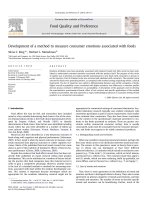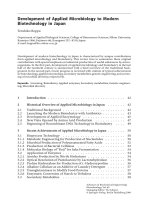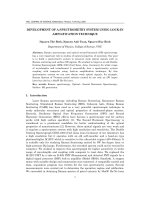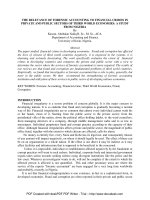Development of Applied Microbiology to Modern Biotechnology in Japan
Bạn đang xem bản rút gọn của tài liệu. Xem và tải ngay bản đầy đủ của tài liệu tại đây (282.41 KB, 30 trang )
Advances in Biochemical Engineering/
Biotechnology,Vol. 69
Managing Editor: Th. Scheper
© Springer-Verlag Berlin Heidelberg 2000
Development of Applied Microbiology to Modern
Biotechnology in Japan
Teruhiko Beppu
Department of Applied Biological Sciences, College of Bioresource Sciences, Nihon University,
Kameino 1866, Fujisawa-shi, Kanagawa 252–8510, Japan
E-mail:
Development of modern biotechnology in Japan is characterized by unique contributions
from applied microbiology and bioindustry. This review tries to summarize these original
contributions with special emphasis on industrial production of useful substances by micro-
organisms. In the first part, development of applied microbiology and bioindustry in the last
half of the twentieth century is summarized with a brief overview of the traditional back-
ground. In the second part, recent progress is reviewed with citation of typical achievements
in biotechnology, applied enzymology, secondary metabolites,genetic engineering, and screen-
ing of microbial diversity, respectively.
Keywords.
Screening, Bioindustry, Applied enzymes, Secondary metabolites, Genetic engineer-
ing, Microbial diversity
1Introduction . . . . . . . . . . . . . . . . . . . . . . . . . . . . . . . 42
2 Historical Overview of Applied Microbiology in Japan . . . . . . . 42
2.1 Traditional Background . . . . . . . . . . . . . . . . . . . . . . . . . 42
2.2 Launching the Modern Bioindustry with Antibiotics . . . . . . . . . 43
2.3 Development ofApplied Enzymology . . . . . . . . . . . . . . . . . 45
2.4 New Vista Opened by Amino Acid Production . . . . . . . . . . . . 47
2.5 Beginning of Recombinant DNA Technology in Bioindustry . . . . 49
3 Recent Achievements of Applied Microbiology in Japan . . . . . . . 50
3.1 Bioprocess Technology . . . . . . . . . . . . . . . . . . . . . . . . . 50
3.1.1 Metabolic Engineering for Production of Nucleotides . . . . . . . . 50
3.1.2 Microbial Production of Polyunsaturated Fatty Acids . . . . . . . . 52
3.1.3 Production of Bacterial Cellulose . . . . . . . . . . . . . . . . . . . 52
3.1.4 Molecular Biology of “Koji” for Sake Fermentation . . . . . . . . . . 54
3.2 Application of Enzymes . . . . . . . . . . . . . . . . . . . . . . . . . 54
3.2.1 Amides Production by Nitrile Hydratases . . . . . . . . . . . . . . . 54
3.2.2 Optical Resolution of Pantolactone by Lactonehydrolase . . . . . . 56
3.2.3 Proline Hydroxylase for Production of l-Hydroxyproline . . . . . . 56
3.2.4 Alkaline Cellulase as an Additive of Laundry Detergent . . . . . . . 57
3.2.5 Transglutaminase to Modify Food Proteins . . . . . . . . . . . . . . 57
3.2.6 Enzymatic Conversion of Starch to Trehalose . . . . . . . . . . . . . 58
3.3 Secondary Metabolites . . . . . . . . . . . . . . . . . . . . . . . . . 58
3.3.1 Pharmaceuticals of Microbial Origins . . . . . . . . . . . . . . . . . 61
3.3.2 Molecular Genetics of Secondary Metabolism . . . . . . . . . . . . 62
3.4 Genetic Engineering for Production of Heterologous Proteins . . . 64
3.4.1 Protein Engineering of G-CSF . . . . . . . . . . . . . . . . . . . . . 65
3.4.2 Host-Vector System of Bacillus brevis . . . . . . . . . . . . . . . . . 65
3.4.3 Production of Human Serum Albumin . . . . . . . . . . . . . . . . 66
3.4.4 Cloning of Thrombopoietin cDNA . . . . . . . . . . . . . . . . . . . 66
3.5 Exploiting Microbial Diversity . . . . . . . . . . . . . . . . . . . . . 67
3.5.1 Extremophiles . . . . . . . . . . . . . . . . . . . . . . . . . . . . . . 67
3.5.2 Microbial Consortia or Symbiotic Systems . . . . . . . . . . . . . . 68
References . . . . . . . . . . . . . . . . . . . . . . . . . . . . . . . . . . . . 68
1
Introduction
Science and technology are international but their development can be affected
by regional characteristics. This aspect is observed with development of bio-
technology in Japan, which is characterized by unique contributions from
applied microbiology and bioindustry. During the second half of the twentieth
century, bioindustry in Japan has made rapid progress by developing many
innovative processes for microbial production of a variety of useful substances
including foodstuff additives, enzymes, pharmaceuticals, pesticides, and other
chemicals. Applied microbiology played crucial roles in this development espe-
cially through discovery of novel microbial functions by means of extensive
screening. Bioindustry also played important roles for industrialization of
new biotechnology as manifested in the production of heterologous proteins
by recombinant DNA technology. Experiences with the microbial diversity as
well as basic understandings on the molecular mechanisms in microbial cells
accumulated during these decades led to transformation of applied microbio-
logy into a characteristic complex of modern biotechnology. This review deals
with personal overview about a brief history of this development along with its
latest achievements.
2
Historical Overview of Applied Microbiology in Japan
2.1
Traditional Background
Japan has a long tradition in the fermentation industry to produce rice wine
“sake” and a variety of fermented foodstuffs such as fermented soy sauce
“shoyu”.Before introduction of modern science and technology at the end of the
last century, engineer’s guilds in the brewing manufacturers had established a
sophisticated system of rational technologies, even empirically. The best example
is the sake brewing process, in which saccharification of rice starch by amylases
42
T. Beppu
from a fungus Aspergillus oryzae and ethanol fermentation by yeast Saccharo-
myces cerevisiae proceed in parallel in a fermenter. Fine techniques to control
microflora enabled stable operation of this complex process to produce ethanol
at the world-highest concentration as high as 20% with an inherent flavor of
high quality.
Interestingly enough, the first industrial application of microbial enzymes
started in the USA in 1894 was a direct descendant of the sake brewing tech-
nology, which was made by a Japanese scientist, Jokichi Takamine, in Peoria,
Illinois. He modified the traditional solid-state culture process of A. oryzae for
industrial production of a mixed enzyme preparation “Taka-Diastase” contain-
ing amylases and other extracellular enzymes, and applied the preparation first
to the production of alcoholic beverage from grains and then to the treatment of
dyspepsia or indigestion. This was a pioneering enterprise for application of
microbial enzymes, whose lineage can still be traced in several companies in
the USA and Japan. It also heralded the following general trend to replace the
enzyme resources from higher plants or animals to microorganisms.
An event that exerted strong influence on the later development of bio-
processes in Japan is the discovery of monosodium l-glutamate as a flavor
enhancer of food in 1908. Kikunae Ikeda, Professor of the University of Tokyo,
was interested in dried kelp, a traditional seasoning material for cooking in
Japan, and succeeded in identifying the amino acid as the essence of its flavor.
Ajinomoto (meaning Essence of Flavor) Co. started its industrial production by
acid hydrolysis of wheat gluten in 1909, and thus opened a big market of food
flavor. This original invention prepared the basis for the later innovation of the
amino acid process.
Success in developing unique technologies through screening of new micro-
bial functions may be one of the major features of applied microbiology in
Japan.Kin-ichiro Sakaguchi (1897–1994),a leader of applied microbiology from
the beginning, once made a short remark that has been passed among his
students during these decades: “I have never been disappointed upon asking
microorganisms for whatever I wanted.” As an embodiment of his statement, a
memorial stone to commemorate the contribution of microorganisms to human
beings is situated in front of an old temple in the historic capital, Kyoto. Such an
atmosphere may also be seen as a traditional background, which has encourag-
ed researchers engaging in screening projects with high risk.
2.2
Launching the Modern Bioindustry with Antibiotics
Research and development of antibiotics played an important role in construct-
ing modern bioindustries from the ruins after the Second World War. The first
scientific information on penicillin described in a medical journal reached
Japan during the war in 1943, which was delivered from Germany by a Japanese
navy submarine. The penicillin research committee consisting of multi-disciplin-
ary researchers was quickly organized and succeeded in realizing small-scale
production of penicillin by surface culture by 1945.Real potential of the research
system was expressed after the war upon the generous introduction of Penicillium
Development of Applied Microbiology to Modern Biotechnology in Japan
43
44
T. Beppu
chrysogenum strain Q176 from the USA in 1946. The research association re-
organized by incorporating industrial members took a principal role in research
and development, and achieved stable industrial production of penicillin by
submerged culture within a few years.A similar strategy was once again adopt-
ed to develop streptomycin production to meet urgent demand to cure tuber-
culosis patients, the death rate of which exceeded 180 per 100,000 persons in
1948, and succeeded in much faster development than the former case. Close
association between academia and industries in the field of applied micro-
biology has originated during these developmental days.
Then discovery of a number of new antibiotics of practical usefulness, such
as the first 16-membered macrolide antibiotic leucomycin (1953), mitomycin C
(1956), and kanamycin (1957), followed soon after. Those are the indications
that the principal methodologies for research and development of antibiotics,
especially random screening of new antibiotic producers from nature, firmly
took root in many research groups and companies.Among them, Umezawa and
his group, first at the University of Tokyo and later at his own Institute of Micro-
bial Chemistry, played a leading role. Kanamycin discovered by his group was
very effective against multi-drug-resistant pathogens and tuberculous bacilli
[1]. Later, bacteria resistant to kanamycin appeared, then Umezawa revealed a
resistance mechanism due to an inactivating enzyme transferring phosphate
group to 3¢-OH of the antibiotic [2]. Armed with this knowledge, he chemically
derived 3¢,4¢-dideoxykanamycin, dibekacin, active against the resistant strains.
This was a very early example of the rational design of antibiotics. It should
also be noted that his success was supported by the results of basic research on
the antibiotic-resistant bacteria. In fact, R-plasmids of the enteric bacteria were
discovered in Japan in 1959 ahead of other countries.
Sarkomycin and mitomycin C, the latter of which is still being widely used
in cancer chemotherapy, were discovered in the 1950s. This means that expan-
sion of the targets of screening beyond antibiotics started early. In this direc-
tion Umezawa and his colleagues again showed leadership and creativity
by initiating a new strategy of screening, i.e., screening of agents inhibiting
enzymes involved in diseases or symptoms. Pepstatin, a specific inhibitor of
pepsin and other aspartic proteases, is an initial example [3]. It is evident that
his idea has opened up an aspect of the current rational approach of targeted
screening.
Blasticidin S (1958) is the first antibiotic used in agriculture to prevent rice
blast caused by a pathogenic fungus, Piricuralia oryzae. Use of its offspring
such as kasugamycin [4] and polyoxin [5] has contributed to Japanese agri-
culture by reducing mercuric pesticides hitherto used in large amounts in fields.
It may be appropriate to mention plant growth hormone giberellin briefly
here in relation to these agro-antibiotics. It was originally found by Japanese
scientists as a virulent agent of a plant pathogenic fungus, Giberella fujikuroii,
which causes abnormal elongation of rice seedlings. The presence of an active
substance in the culture filtrate of the fungus was reported very early in 1926
and the agent, giberellin, was identified by Yabuta and Sumiki in 1938 [6]. It is
now produced on a large scale and used widely for producing seedless grapes in
Japan.
2.3
Development of Applied Enzymology
Extensive screening of microbial strains proved to be a powerful tool for deve-
lopment of not only antibiotics but also industrial enzymes. Very early dis-
coveries of several unique enzymes of great industrial usefulness and sub-
sequent discoveries of a variety of unique applied enzymes of microbial origins
conferred one of the characteristic features on the current biotechnology in
Japan (Table 1).
In addition to dried kelp that provided monosodium l-glutamate, dried fish
meat of skipjack tuna has been another traditional seasoning material for cook-
ing in Japan.A preliminary paper describing inosinic acid as the essence of this
flavor appeared in 1913, long before the establishment of nucleotide chemistry.
Kuninaka [7] reexamined this work and revealed that 5¢-inosinic and guanylic
acids, but not the 2¢- and 3¢-nucleotides, possess not only a potent flavor them-
selves but also potent flavor-enhancing activity in the presence of monosodium
glutamate.Since only venom nuclease was known to cleave RNA to 5¢-nucleotides,
they screened microorganisms for the activity and found nuclease P1 from a
Penicillium strain [8].Success of the enzymatic processes to produce the nucleo-
tides from yeast RNA triggered the next challenge of nucleotide biosynthesis as
described below.
Discovery of glucose isomerase is a contribution originated from Japan, lead-
ing to worldwide application in the sugar industry. In 1965, Sato and Tsumura
[9] discovered the enzyme from Streptomyces strains, and the batch reactor
system with the Streptomyces hyphae as a catalyst was developed soon after-
wards. Industrial production of fructose + glucose syrup by combined use of
glucose isomerase and glucoamylase started in 1971.
In 1967 Arima and his colleagues [10] found an aspartic protease with potent
milk-clotting activity from a fungus Rhizomucor pusillus.It was the first success-
ful microbial milk-clotting enzyme, which was required to meet the global
shortage of calf chymosin for cheese production. Their invention was quickly
followed by the development of a similar fungal enzyme from a closely related
species R. miehei, and these fungal enzymes had replaced almost half of the
world demands for milk-coagulants until the recent introduction of recombinant
chymosin.
Combined use of microbial enzymes as biocatalysts with chemical synthesis
has its origin in the steroid transformation developed in the USA in the early
1950s.Arima and his group [11] invented a unique microbial conversion process,
in which the aliphatic side-chain of cholesterol was cleaved to produce a steroid
core as a starting material for chemical synthesis of steroid hormones. Yamada
et al. discovered the reverse reaction of the pyridoxal-containing l-amino acid
lyases and applied them to synthesize l-tryptophan and l-DOPA [12] from
pyruvate, ammonia and corresponding aromatic compounds. Since these early
achievements, a variety of unique processes with newly screened microbial
enzymes as biocatalysts have been invented.
Discovery of alkalophilic bacteria and their alkaline enzymes by Horikoshi in
1971 [13] was a direct demonstration of the microbial diversity. Since then,
Development of Applied Microbiology to Modern Biotechnology in Japan
45
46
T. Beppu
Table 1.
Examples of useful enzymes of microbial origins discovered since 1950
Enzymes and/or Products
a
Origins of enzymes References
Penicillin acylase J Agr Chem Soc
23:411(1950)
Glucoamylase Bacillus amylosacchariticus Proc Japan Acad
27:352(1951)
Nuclease P1/5¢-ribonucleotides
a
Penicillium citrinum see text
Lipase Rhizopus delemer J Gen Appl Microbiol
10:257(1964)
Glucose isomerase Streptomyces sp see text
Milk-clotting protease Rhizomucor pusillus see text
Cholesterol transformation Arthrobacter simplex see text
Tyrosine-phenol lyase/l-DOPA
a
Enterobacteriaceae see text
Serratiopeptidase Serratia sp Agric Biol Chem
34:310(1970)
Asparaginase E. coli Agric Biol Chem
35:743(1971)
Heat-stable lipase Humicola ranuginosa Agric Biol Chem
36:1913(1972)
CGTase/cyclodextrin
a
Alkalophilic Bacillus Agric Biol Chem
40:935(1976)
Cholesterol oxidase Brevibacterium sterolicum Agric Biol Chem
38:149(1974)
Caprolactam hydrolase/l-lysine
a
Cryptococcus sp Agric Biol Chem
41:1327(1977)
Hydantoinase/d-amino acid
a
Pseudomonas striata J Ferm Technol
56:484(1978)
Lysyl endopeptidase/h-insulin
a
Achromobacter lyticus Nature 280:412(1979)
Nitryl hydratase/acrylamide
a
Pseudomonas chloraphis see text
Alkaline endolytic cellulase Alkalophilic Bacillus J Bacteriol
158:503(1984)
Arabinonucleoside
a
Enterobacter aerogenes Agric Biol Chem
49:3239(1985)
Fungal peroxidase Arthromyces/Coprinus Agric Biol Chem
50:247(1986)
Cephalosporin acylase Pseudomonas sp J Bacteriol
169:5815(1987)
Protopectinase Bacillus subtilis Biosci Biotech Biochem
58:353(1994)
Lactone hydratase/d-pantolactone
a
Fusarium oxysporum see text
Trehalose
a
Arthrobacter sp see text
Transglutaminase Streptoverticillium sp see text
Proline hydroxylase Dactylosporandium sp see text
a
Products produced by the enzyme processes are indicated instead of enzyme names.
a number of extracellular enzymes, such as proteases, amylases, cyclodextrin
glucanotransferases (CGTase) and cellulases,with highly alkaline optimum pHs
have been found mostly from alkalophilic Bacillus for various application. His
work has initiated a trend leading to the current concept of extremophiles as
described below.
It is also noted that Chibata and his colleagues [14] of Tanabe Pharmaceutical
Co.started to use an immobilized enzyme for the optical resolution of dl-amino
acids in 1969. The process included a fungal acylase immobilized on DEAE-
Sephadex to hydrolyze N-acyl-l-amino acids selectively. This was the first indu-
strial use of immobilized enzymes leading to the present concept of bioreactors.
2.4
New Vista Opened by Amino Acid Production
Discovery of glutamate production was a milestone in the history of Japanese
process biotechnology, not only because of its own originality but also due
to its role in creating a new paradigm of bioprocess technology leading to
the current metabolic engineering. In 1956, Udaka and Kinoshita of Kyowa
Fermentation Industry Co. reported the discovery of a novel bacterium Coryne-
bacterium glutamicum (initially reported as Micrococcus glutamicum), which
accumulated a large amount of l-glutamate from glucose and ammonia [15].
At that time this was almost an unpredictable phenomenon in the scope based
upon the knowledge on the ethanol process. Technologically, a smart assay
system to detect l-glutamate-producing colonies by using a glutamate-requir-
ing bacterium as an indicator was a key to the success in this screening (Fig. 1).
Enhanced leakage of l-glutamate due to biotin-deficiency of the producing
organism was found to play a central role in the large accumulation, and peni-
cillin-treatment was invented to assure the leakage in the biotin-rich industrial
media. Ajinomoto quickly followed to protect its original market by using a
similar organism, Brevibacterium flavum, and several other companies also
engaged in this promising field of biotechnology. Although the competition
caused some confusion in nomenclature of these producing strains, it has result-
ed in recognition of the Coryne-form bacteria as a unique phylogenetic group in
bacterial systematics.
It is remarkable that accumulation of l-lysine in large amounts by an auxo-
trophic mutant of C. glutamicum was achieved within a year after the report of
the glutamate process. The research group of Kyowa found that a homoserine-
requiring mutant of C. glutamicum accumulated large amounts of l-lysine
instead of l-glutamate [16]. Although the molecular mechanisms of neither the
feedback regulation of amino acid biosynthesis nor the lac-operon induction in
E. coli had yet been clarified at that time, this work suggested the presence of
some regulatory networks as a key to switch biosynthetic pathways of amino
acids. Detailed regulatory mechanisms were then revealed in E. coli,and the
basic information facilitated to construct mutant strains accumulating various
l-amino acids; these are described in another chapter of this volume.The rational
approach used in these developments can be assumed to be a new field of fermen-
tation, which is now called metabolic engineering.
Development of Applied Microbiology to Modern Biotechnology in Japan
47
48
T. Beppu
It is interesting to note that the discovery of marked flavor enhancing activity
of 5¢-inosinic and guanylic acids was made in 1960 just at the beginning of amino
acid production [7].Although the enzymatic hydrolysis of yeast RNA had achiev-
ed a distinct industrial success as described above, bioprocesses to produce
these nucleotides were attempted by an approach similar to that used in develop-
ing the amino acid-producing strains. Accumulation of inosine and guanosine
in large amounts was achieved by using adenine-requiring mutants of Bacillus
subtilis, which were then chemically phosphoryalted to the corresponding
Fig. 1.
Method of screening for glutamate producers
nucleotides [17]. On the other hand, Furuya et al. [18] reported direct accumu-
lation of 5¢-inosinic acid by an adenine-requiring mutant of Brevibacterium
ammoniagenes, whose leakage seemed to be caused by the cell membrane
abnormality induced at decreased concentrations of Mn
2+
.A Mn
2+
-insensitive
mutant was derived from the strain so as to achieve the accumulation even in the
presence of excessive Mn
2+
in the industrial media [19]. These methods became
a starting point for successive development of the nucleotide production
systems as described below.
Several Japanese companies mainly conducted these innovative develop-
ments,and the severe technological race reproduced the stimulatory atmosphere
of research and development that had once been observed at the beginning of
the antibiotics industry.In such circumstance,the idea to manipulate genetically
metabolic pathways was widely adopted in other bioprocesses as seen in
construction of yeast strains with low diacetyl production for beer brewing [20].
In addition to creating metabolic engineering as a new paradigm of tech-
nology, these activities posed fundamental problems important in the basic
microbiology. Enhanced leakage of l-glutamate in the Coryne-form bacteria
is one such example, and elucidation of its molecular mechanisms is now a
fascinating topic of the current bacterial physiology [21]. It should also be
mentioned that experiences and techniques obtained during this research and
development provided the basis for the following introduction of genetic
engineering.
2.5
Beginning of Recombinant DNA Technology in Bioindustry
As soon as recombinant DNA technology appeared, many pharmaceutical
and fermentation companies enthusiastically started research and development
to produce heterologous proteins of human origin, mostly by using E. coli
host-vector systems. Experience in microbial breeding and facilities of bio-
processes hitherto accumulated in Japanese industries enabled them to intro-
duce some relevant licenses from abroad, while several cDNAs originally cloned
in Japan, such as interferon-
b
[22], and IL-2 [23], were also developed for
industrial production. Cloning and expression of chymosin cDNA in E. coli is
noted as an early case applying this technology to targets other than medicinal
use [24].
In order to apply recombinant DNA-technology to a wider variety of micro-
organisms, new host-vector systems were developed. Among them, the system
for the amino acid-producing Coryne-form bacteria [25, 26] was useful for
genetic analyses and molecular breeding of this group of bacteria. The system of
Bacillus brevis is unique in its low proteolytic activity and high efficiency to
secrete protein products, and was recently used for production of hEGF as
described below [27].
Research and development of recombinant DNA technology has recently been
expanding more and more rapidly. Global trends exemplified by the genome
projects begin to exert profound effects on the future strategy of development,
but those are beyond the scope of this brief review.
Development of Applied Microbiology to Modern Biotechnology in Japan
49
3
Recent Achievements of Applied Microbiology in Japan
3.1
Bioprocess Technology
The great success of amino acid and nucleotide processes revealed the capability
of the genetic approach to overcome cognate regulatory networks in bacterial
cells to achieve industrial production of metabolic intermediates of practical
usefulness. Development of the host-vector system for the Coryne-form bacteria
provided more freedom to manipulate the metabolic pathways. Since advances
in the amino acid process are described in another chapter, here the recent
development of the nucleotide production, especially unique hybrid processes
constructed by coupling multiple microbial cells with different catalytic activi-
ties are described. Metabolic engineering for production of unsaturated fatty
acids and a project to develop bacterial cellulose as a new industrial material are
recent examples of research and development to expand the possibility of bio-
technology. On the other hand, introduction of new technologies into the tradi-
tional brewery industry is producing several achievements such as recent mole-
cular analyses of solid-state process of Aspergillus oryzae.
3.1.1
Metabolic Engineering for Production of Nucleotides
Bioprocesses to produce 5¢-IMP and 5¢-GMP have been classified into two types
in general. One is a two-step process composed of production of nucleosides by
bioprocess followed by chemical phosphorylation, and the another is the direct
bioprocess accumulation of 5¢-IMP and 5¢-xanthilic acid (XMP). As the exten-
sion of the second one, the research group of Kyowa Fermentation Industry has
developed the process to hybridize the strong ATP-regenerating activity of
Corynebacterium with the reaction catalyzed by other microbial cells.
First they developed the process for production of 5¢-GMP by hybridizing the
XMP fermentation of Corynebacterium ammoniagenes with the energy-requir-
ing amination reaction catalyzed by GMP synthase [28]:
5¢-XMP + NH
3
+ ATP Æ 5¢-GMP + AMP + PPi
In order to achieve the amination effectively, recombinant E. coli cells harboring
the GMP synthase gene under the control of the lP
L
promoter on a multi-copy
plasmid was constructed, and the ATP-regeneration system in the C. ammonia-
genes cells was used to supply ATP for this reaction. In order to assure the supply
of ATP to the amination reaction, both of the two bacteria were treated with a
mixture of detergent and solvent (polyoxyethylene stearylamine + xylene). The
treatment made the cell membranes permeable to ATP but caused no damage to
the ATP regeneration system in C. ammoniagenes. The whole process is operat-
ed in two steps: the first step is production of 5¢-XMP by C. ammoniagenes alone,
and then the recombinant E. coli cells are added to convert 5¢-XMP to 5¢-GMP
50
T. Beppu
(Fig. 2). A final yield of 70 g l
–1
as 5¢-GMP · Na
2
·7H
2
O with the conversion rate
of 5¢-XMP at 85% can be obtained.
A similar method was applied to produce 5¢-IMP from inosine, which was
accumulated by a mutant strain of C. ammoniagenes [29]. In order to convert
inosine to 5¢-IMP, recombinant E. coli with high activity of guanosine/inosine
kinase was constructed by cloning the E. coli gene on an overexpressing plasmid.
Although production of 5¢-IMP was possible by the direct bioprocessing, the
hybrid system allowed far higher bioprocess productivity. The process seems
to have several advantages to the former processes in regards to not only
productivity but also flexibility in applying to production a variety of phos-
phorylated compounds. Thus the system has been used for production of
several phosphorylated materials such as CDP-choline [30], and UDP-galactose
as well as globotriose [31].
Development of Applied Microbiology to Modern Biotechnology in Japan
51
Fig. 2.
Hybrid process to produce 5¢-GMP catalyzed by cells of Corynebacterium ammonia-
genes and recombinant E. coli
3.1.2
Microbial Production of Polyunsaturated Fatty Acids
Polyunsaturated fatty acids (PUFAs) represented by linoleic and linolenic acids
have been recognized as essential fatty acids for nutrition. Several members
such as Mead, arachidonic, and eicosapentaenoic acids are known to be pre-
cursors of prostaglandins, thromboxanes, leucotrienes, etc., all of which have
a variety of physiological activities like hormones. Some of them such as docosa-
hexaenoic acid are recommended as dietary supplements for the prevention of
heart diseases. Because of the increasing interest in and demand for the biologi-
cally important PUFAs, Shimizu and his group [32] extensively screened micro-
organisms that produced large amounts of PUFAs, and found a fungus Mortiella
alpina and related species belonging to the genus Mucorales.Submerged cultiva-
tion of a strain of M. alpina for 5–7 days in the medium containing soybean oil
yielded mycelia containing more than 50 wt% of arachidonic acid and the yield
of arachidonic acid reached 4–8 kg l
–1
. Thus the fungus is capable of being used
as an effective resource of “Single Cell Oil” with high contents of arachidonic
acid.
They further extended their work by isolating desaturase-deficient mutants
of the fungus to manipulate biosynthetic pathways of PUFAs (Fig. 3). The main
product of the strain, arachidonic acid,is synthesized via the
w
-6 route,in which
four kinds of desaturases D
5
, D
6
, D
9
,and D
12
are involved. Desaturase-deficient
mutants have been isolated from several fungi and yeasts depending on the
lethal or abnormal phenotype of development, but their mutations are limited
to the D
9
-desaturase. Shimizu and his group isolated mutants of M. alpina by
analyzing fatty acids composition of all the colonies treated with nitrosoguani-
dine.This approach allowed them to obtain mutants of all the desaturases,which
provides important information on their roles in the biosynthesis of PUFAs.
Up to now, they have achieved production of dihomo-
g
-linolenic acid by using a
D
5
-desaturase-deficient mutant, and of Mead acid by a D
12
-desaturase-defective
mutant.
3.1.3
Production of Bacterial Cellulose
It is well known that some strains of Acetobacter, namely A. xylinum,produce
large amounts of cellulose as thick films in liquid stationary culture.Yamanaka
et al.[33] noticed marked physical properties of dried bacterial cellulose sheets,
which showed a high rigidity or Young’s modulus similar to steel along with
high internal loss to repress reverberation comparable to paper. His finding
resulted in Sony’s high quality acoustic transducer “Bio”diaphragm and thus
stimulated interests in the possibility of this material. A research venture,
Bio-Polymer Research Co., was organized by several companies with public
budget supports for 1992–98 to exploit the possibility. In order to achieve mass
production of bacterial cellulose at profitable costs, screening of hyper-pro-
ducing strains in submerged culture and development of mechanical systems
for the culture with extreme viscosity were carried out. As the consequence,
52
T. Beppu









